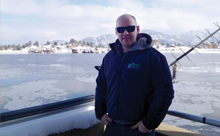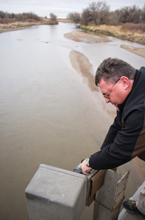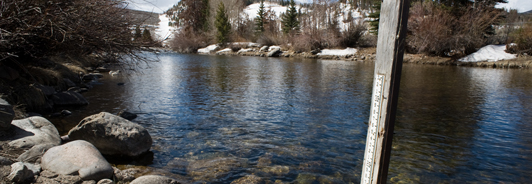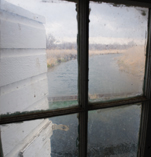The Water Gatekeepers
Commissioners carry on the time-honored practice of monitoring levels in Colorado to manage complexities of flows to households and farms
— Story by Joshua Zaffos, photography by Kevin Moloney
Driving to the west of Loveland, along an unpaved stretch of the old U.S. 34, where the historic path veers behind the renowned Dam Store, Jason Smith (BA-07) is moving through the intersection of history and hydrology. He steers his Ford F150 away from the modern asphalt road, which curves up Big Thompson Canyon toward Estes Park. He then turns toward Green Ridge Glade Reservoir, which holds the municipal water supply for the city of Loveland.
As the District 4 water commissioner for the Colorado Division of Water Resources, Smith is doing his monthly check of reservoir levels within the Big Thompson River Basin to help him prepare for the upcoming spring snowmelt and runoff. The task is as old as the post of water commissioner, which dates back to 1879, when Colorado officially began recognizing water rights and managing the flows that pulse through streams and irrigation ditches
 SINCE 1879: Water commissioners, like
SINCE 1879: Water commissioners, like
Jason Smith (BA-07), inform cities when they can fill their reservoirs and when water-rights holders must limit use. Photo courtesy of
Jason Smith.
Smith is among 114 commissioners across the state, each patrolling a district covering part, or all, of a river basin. Their job of administering water rights based on legal priority and the decrees of the state’s water courts is both straightforward and nebulous. Depending on climate and weather, runoff rates and stream volumes, commissioners say when cities can fill their reservoirs, or irrigation companies can open their diversion ditches. Sometimes known as water cops, they are also faced with telling people when they must limit their diversions to protect senior, or older, water rights.
Smith finds Green Ridge Glade and other reservoirs sitting at relatively high and steady levels through early February. But the dry and windy Colorado winter serves as a forewarning. Smith has heard from plenty of colleagues and ditch riders that the seasonal conditions so far are reminiscent of the brutal drought of 2002 — supported by media reports in May that statewide snowpack totals were tracking at 19 percent of the 30-year average.
Working long hours and often tramping through the field, or buried under paperwork, water commissioners are unsung heroes in keeping water flowing to farm fields and household faucets. In many ways, the job hasn’t changed much in 130 years — except for the pickup trucks and stream-gauge technology that greatly reduce uncertainty and delays.
“The water commissioner is an elusive creature,” Smith says.
That may be the case, but water commissioners are creating an evident legacy at UNC. Building on skills and interests cultivated in the Geography and Environmental Science departments, UNC graduates serve as commissioners all over Colorado. The state Division of Water Resources’ Greeley regional office counts eight graduates, including Smith, on its own.
•••••
 ROAD WARRIOR: Brent Schantz (BA-93) uses a wire weight to get a stage level at the Kersey gauging station.
ROAD WARRIOR: Brent Schantz (BA-93) uses a wire weight to get a stage level at the Kersey gauging station.
Brent Schantz (BA-93) fell for the profession as a student intern. “I rode around with the District 4 water commissioner and knew that this was what I wanted to do,” he says.
A native of Fort Morgan, Schantz completed three student internships with the guidance and help of his Geography professors. He started in a temporary position in the Greeley water-resources office when he graduated, before landing a fulltime job.
Schantz is now the commissioner for districts 1 and 64, administering 158 miles of the lower South Platte River in eastern Colorado, including the area where he grew up.
The expansive region — which takes 2 ½ hours to cover by vehicle — is complicated hydrological terrain with both surface-water and groundwater rights. When the 2002 drought was in full swing, Schantz worked long hours as low-river flows forced senior calls resulting in curtailment of junior rights and well pumping. Farmers pumping groundwater battled surface-water irrigators, and Schantz faced death threats over curtailment of diversions.
With people’s livelihoods at stake, he felt compelled to have kitchen-table talks with farmers to explain the situation and build lasting relationships. He’s been vigilant to keep the lines of communication open since.
In the aftermath of the drought and a state Supreme Court ruling, groundwater users now have to replace depletions to the river. One method is using recharge ponds. Previously, a few dozen existed on the Eastern Plains; now, there are 450, says Schantz. Four deputy commissioners stationed farther east help him with monitoring.
Schantz’s districts are also changing, as cities target the region for “buy-and-dry” — a strategy of purchasing water rights from rural irrigation companies and legally changing them for municipal uses, depriving farms of water and often forcing their closure. While lawmakers and water managers are seeking alternatives to preserve farming and meet cities’ needs, Schantz and his staff dedicate their time to protecting decreed rights.
•••••
Schantz has helped other UNC students follow in his footsteps. When there’s been an internship or job opening, he has reached out to former Geography professors, including department chair James Doerner, to recommend candidates. After a call from Schantz in early 2006, Doerner encouraged Smith to apply for a temporary position, which eventually led to his water commissioner job.
 TOOLS OF THE TRADE: Commissioners
TOOLS OF THE TRADE: Commissioners
spend time in the field verifying diversions
of water with the help of data-loggers,
right, and can also get updates on realtime
flows remotely thanks to advancing
technology in telemetry.
“The Geography department is kind of in a shadow on campus,” says Scott Hummer (BA-89), who worked for 21 years as the Blue River commissioner in Summit County and is now project manager for Colorado Water Trust. “They have a tremendous staff and produce some very quality employees that work for the agency.”
Course offerings in the close-knit department, which has around 20 graduates per year, allow students to study physical landscapes in classes and afield. Students also learn to use geographic information systems (GIS) computer applications.
“The skill set fits nicely with the work that water commissioners do,” Doerner says.
Not that the department has a monopoly on producing water commissioners.
Shera Sumerford (BA-00) found her way into the field after taking a waterpolicy course with Tom Cech, a water expert in his own right and former director of the Central Colorado Water Conservancy District, based in Greeley. After being inspired by Cech’s class, Sumerford, an Environmental Science major, sought an internship in water resources.
She broke in with the regional office in Greeley, and spent her internship working on a team that wandered the Eastern Plains locating and tagging irrigation wells, a chore that “isn’t as bad as it sounds,” she quips. She was offered a job when she graduated, working as a deputy commissioner and hydrographer. In 2008, she became the St. Vrain River water commissioner, a district that includes the city of Longmont.
“I get to be inside, I get to be outside,” Sumerford says, noting that “the water-policy class got me here.
•••••
 WATCHFUL EYE: Shera Sumerford, checking an outflow from a reservoir above, and colleague Smith each monitor 20-30 irrigation ditches in their neighboring districts. Photo courtesy of Shera Sumerford
WATCHFUL EYE: Shera Sumerford, checking an outflow from a reservoir above, and colleague Smith each monitor 20-30 irrigation ditches in their neighboring districts. Photo courtesy of Shera Sumerford
Water commissioners spend a chunk of time over the winter compiling the past year’s records and data. As they keep an eye on reservoir levels, they must also check surface-water diversions. Out on the plains, recharge water comes into priority once the reservoirs are full. Around March, commissioners will check in with ditch companies to see which ones want to start irrigating sooner rather than later and which ones still want to top off reservoirs.
By May, the frenzy of phone calls commences, and they continue until November. Starting around 5:30 a.m. daily, water commissioners are talking with ditch riders and irrigators to set headgate levels, which control how much water is diverted to irrigation canals. Smith says his personal record is 87 calls in one day.
With summer in full swing, commissioners check their surface-water diversions hourly to ensure everyone is taking their fair and legal share of water — and not any more.
While Schantz and his deputies patrol his massive territory, Smith and Sumerford each watch 20 to 30 irrigation ditches and they share the time of a deputy between their adjacent districts. The commissioners spend two or three days during the week in the field verifying diversions, but a recent technology upgrade installed telemetry on gauges, so commissioners and water users throughout the South Platte can follow real-time flows by cell phone or by computer (also available at www.water.state.co.us)
“Things change very quickly and that’s what I love about this job,” Schantz says. “No day is the same.” NV
—Joshua Zaffos is a Fort Collins-based freelance writer who frequently covers the environment, science and technology.







